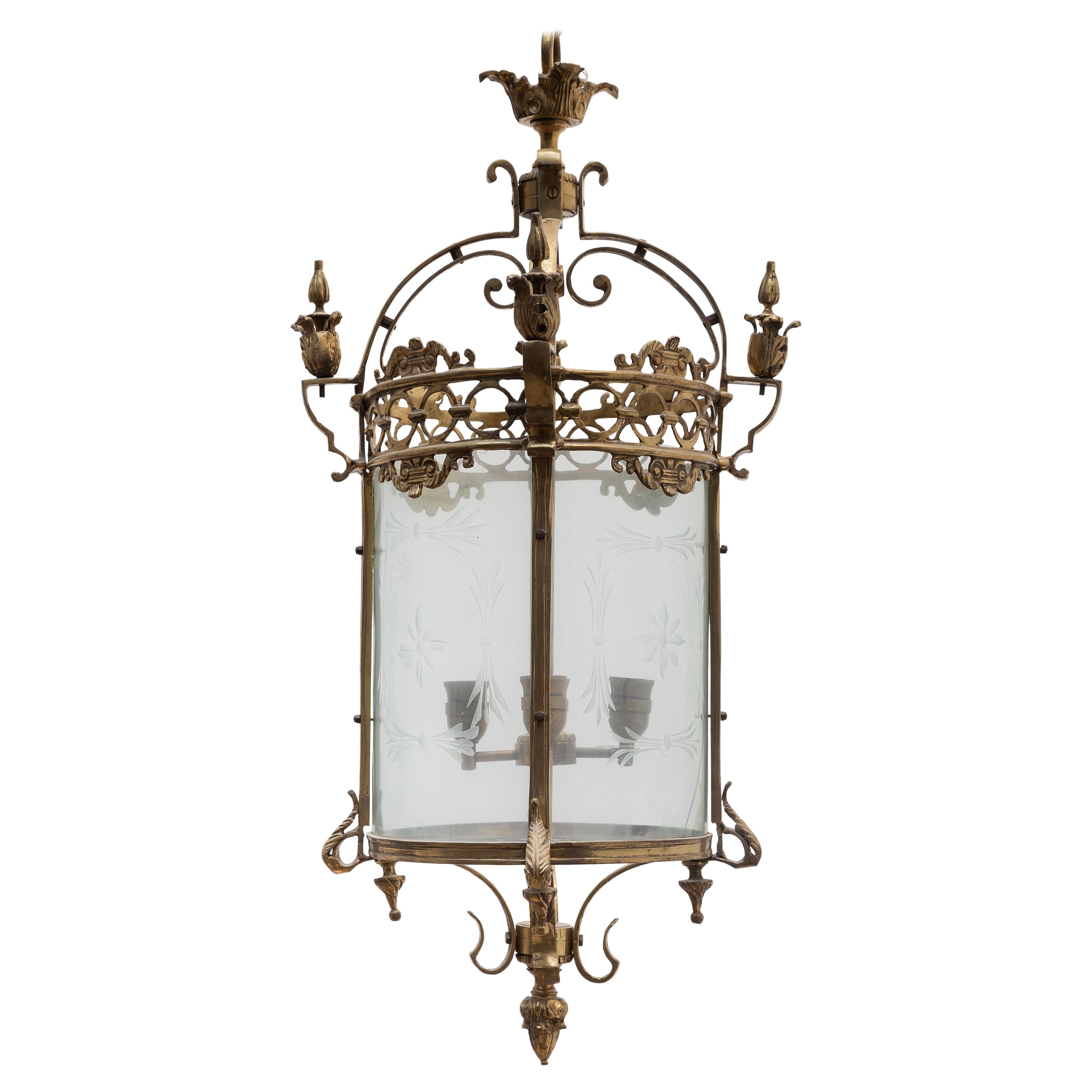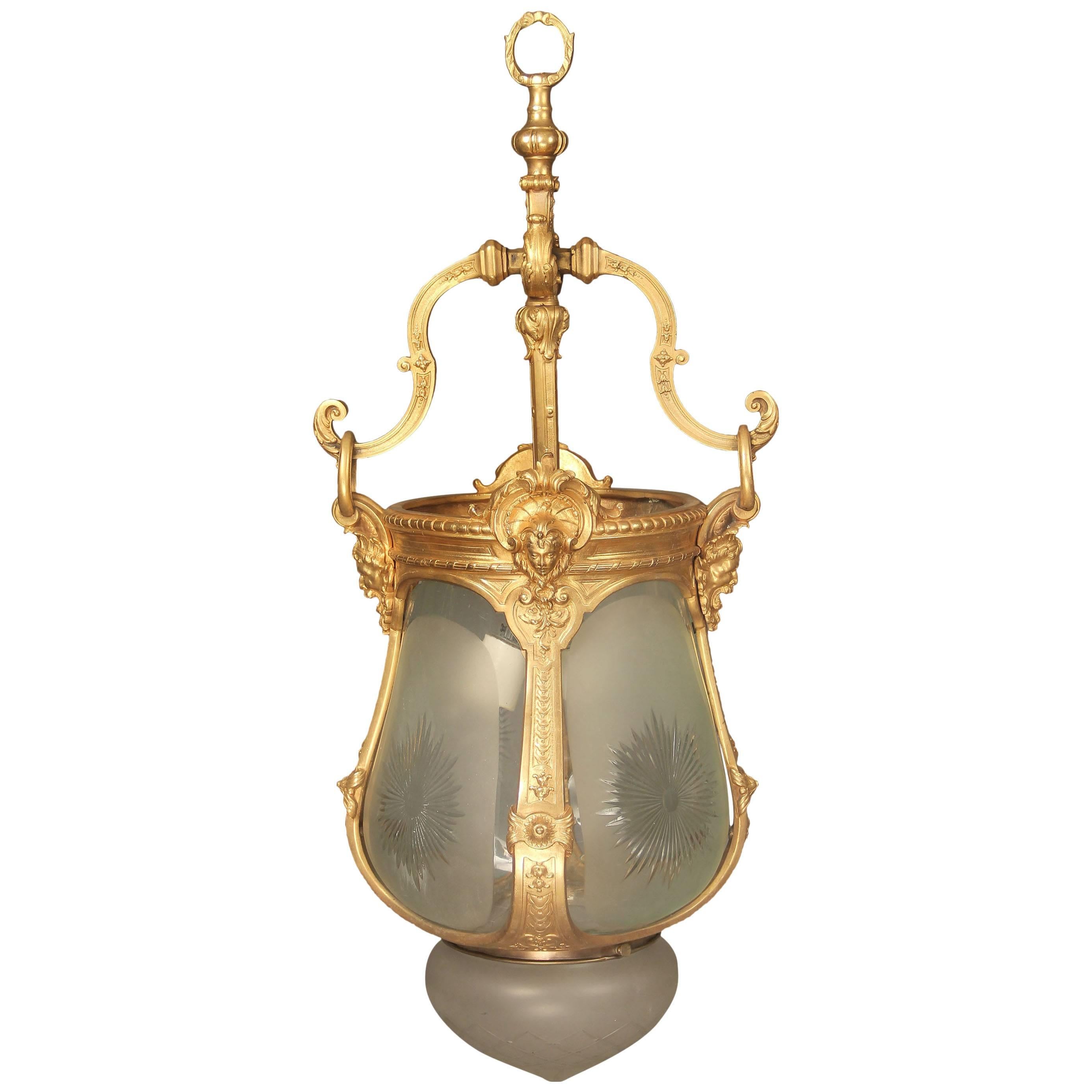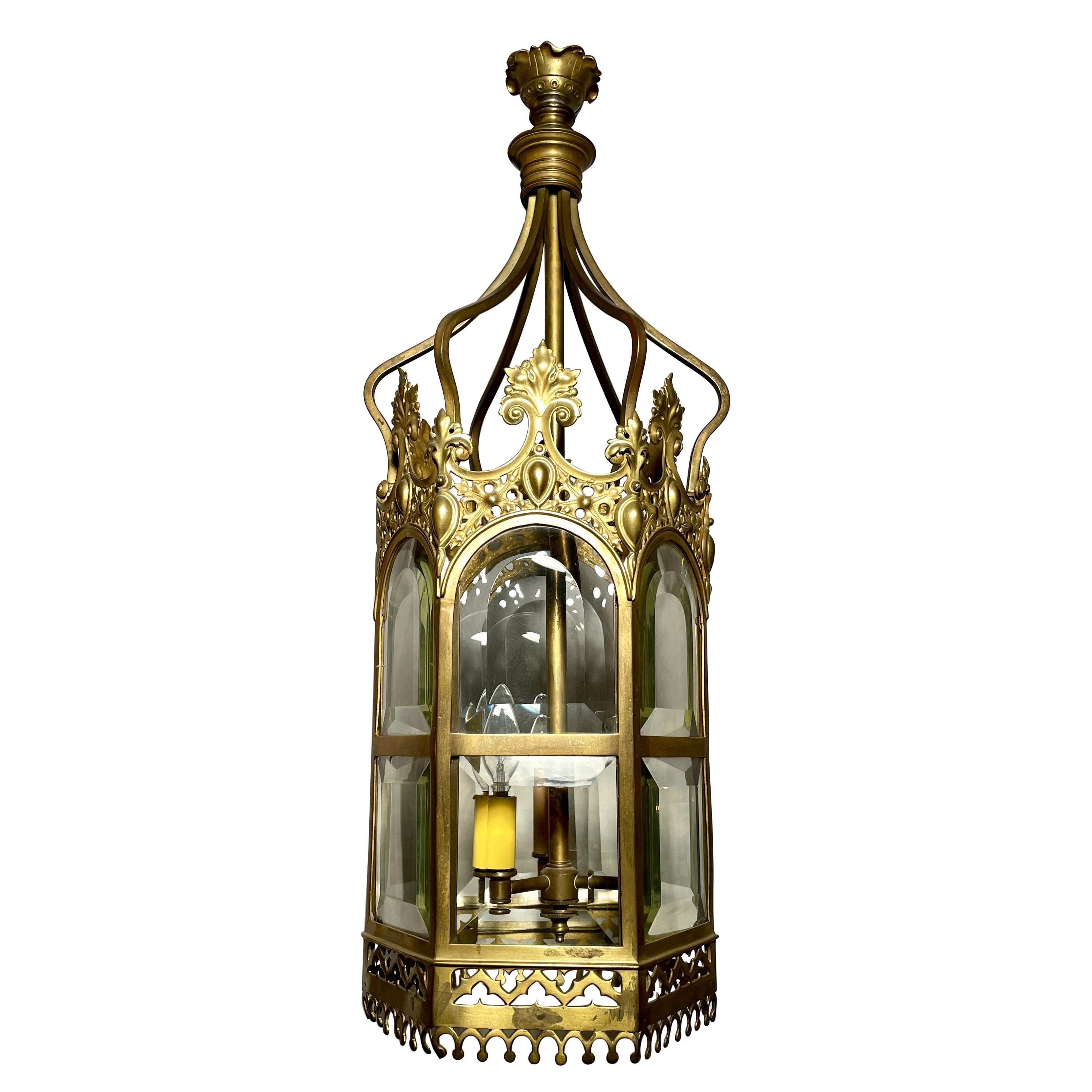Items Similar to Antique Gothic Gilt Bronze Hall Lantern
Video Loading
Want more images or videos?
Request additional images or videos from the seller
1 of 7
Antique Gothic Gilt Bronze Hall Lantern
About the Item
An English 19th-century Gothic gilt-bronze hall lantern.
George IV period, circa 1820-1830.
In superb condition. Later adapted with a 3-way center and wiring.
A very smart Georgian addition to a hallway, entry or foyer.
Measures:
H 2’3” (69 cm)
W 12 ½” (31 cm)
D 12 ½” (31 cm).
Nb:
A very similar antique Gothic lantern was sold by Dreweatts, Newbury, on 30th March 2021, lot 151 for £15,000.
An almost identical late-Regency period hexagonal lantern was sold at Christies, London, for £17,500 on 9th June 2011, lot 201. Dated 1820-1830.
Literature:
Gothic Revival Architecture - Wikipedia.
Rachel Knowles, 'Strawberry Hill - Horace Walpole's Gothic Castle - A Regency History Guide' (2014). Incidentally Strawberry Hill is well worth a visit, particularly for its remarkable and highly unsusual interior decor.
- Dimensions:Height: 69 in (175.26 cm)Width: 31 in (78.74 cm)Depth: 31 in (78.74 cm)
- Style:Gothic (Of the Period)
- Materials and Techniques:
- Place of Origin:
- Period:
- Date of Manufacture:circa 1860
- Condition:Repaired: Later adapted with a 3-way centre and wiring. Wear consistent with age and use. In superb condition.
- Seller Location:Lymington, GB
- Reference Number:
About the Seller
5.0
Vetted Seller
These experienced sellers undergo a comprehensive evaluation by our team of in-house experts.
Established in 1957
1stDibs seller since 2018
33 sales on 1stDibs
Typical response time: 1 to 2 days
- ShippingRetrieving quote...Ships From: Lymington, United Kingdom
- Return PolicyA return for this item may be initiated within 14 days of delivery.
More From This SellerView All
- Pair Regency Period Bronzed Giltwood TorchèresLocated in Lymington, GBA fine and rare pair of English Regency period torchères, or stands (or candle stands) in the manner of Thomas Hope. Circa 1810. Both are raised on tapering simulated-bronze column supports with circular tops and fluted gilt collars, on concave-sided triform bases with winged-panther mask monopodia. The column bases issue from spreading, gilded, carved lotuses. These antique torcheres might also be referred to as columns, ornamental stands, candle sticks, or candelabra. In superb condition throughout. Literature: ‘Thomas Hope – Regency Designer’ ed. David Watkin & Philip Hewat-Jaboor, Yale University Press, New Haven and London (2008). The Aurora Room, Duchess Street, photo from V & A Museum, fig. 68-1, p. 378. The Royal Collection, HM Queen Elizabeth II, RCIN 588- 1-2, 45- 1-2, figs. 78-2, 78-3, p. 396. The Faringdon Collection, Buscot Park, Oxfordshire, illustr. 88, p. 414. The pair of stands we are offering here correspond closely to the pair in the Faringdon Collection (see above). Watkin and Hewat-Jaboor state; ‘’A ‘Roman’ stand of this precise design, perhaps an imaginative variation on one published by Visconti*, is illustrated in ‘Household Furniture’, plate L, number 2… Hope also owned several classical Roman candelabra...Category
Antique Early 19th Century English Regency Candlesticks
MaterialsGiltwood
- Very Rare Carved Gilt Gesso Dressing Mirror, circa 1710-1720Located in Lymington, GBA very rare carved gilt gesso dressing mirror. Queen Anne / George I period, c 1710-20. Decorated all over with the original finely carved gilt-gesso surfaces with typical circular punched reserves. The hinged fall reveals a shaped, fitted interior, gilded and japanned (lacquered) in red. Some external carved surfaces show very minor areas of wear revealing the authentic bole and gesso ground. Overall in superb condition. Measures: H: 39 1/2’’ (100 cm) D: 12 1/2’’ (31.5 cm) W: 17 3/4’’ (45.5 cm). Reminiscent of the work of London-based James Moore (c 1670-1726), a supreme exponent of the art of cut gesso and gilding. This dressing table mirror is possibly unique in this form, and as such has survived over 300 years in remarkably original state. It may have been part of a suite of furniture, would have been extremely costly, and very much the reserve of the aristocracy and the wealthy in the early part of the 18th century. For documented pieces by James Moore viz. The Royal Collection Trust Wikipedia - James Moore (furniture designer) James Moore (circa 1670 - October 1726) was established at Short's Gardens, St. Giles-in-the-Fields. He was in partnership with John Gumley from 1714 and, unlike his partner, did not advertise - the sole published reference to him being a notice of his death in The Weekly Journal or The British Gazetteer. As Royal cabinet-maker he supplied walnut and mahogany furniture for the Royal Household, The Royal Yacht, and the King's servants and mistresses, as well as the rich gilt-gesso work for which he is best known. Moore is especially renowned for gilt-gesso furniture: tables; looking glass frames; and candle stands. A pair of gilt-gesso side tables bearing the crowned cypher of George I in The Royal Collection, and the pair of candle stands en-suite are incised with his name - an unusual practice at the time. At Erddig, such furniture by Moore can be linked to surviving bills and receipts from James Moore and John Belchier, 1722-26. Gilt-gesso furniture is also encountered in fine Louis XlV and other European furniture of the period. Literature: Ralph Edwards CBE FSA ’The Shorter Dictionary of English Furniture’ Hamlyn, London (Fourth Impression 1972) ill. 5, p. 363. One of a pair of looking glasses by James Moore, 1720. Erddig, Denbigh. The crest is reminiscent of that upon our dressing mirror, which we are offering here. Kreisel, Heinrich, 'Die Kunst Des Deutschen Mobels’ CH Beck, Munchen (1970) ill. 345, p. 347 - note similarities in the treatment of the top of the crest. This mirror was last seen in the collection of Augsburg Castle. Synge, Lanto, 'Great English Furniture' London (1991) p. 52. Refs: Symonds, R. W. 'A Royal Scrutoire', Connoisseur (June 1940) pp. 233-236. Symonds, R. W. ‘English Gesso Furniture’, The Antique Collector, Vol. XXVII (August 1956) p. 140. ‘A Golden Cabinet...Category
Antique Early 18th Century Queen Anne Table Mirrors
MaterialsGiltwood
- Pair of Antique BenchesLocated in Lymington, GBA pair of antique benches, or forms - one 18th century, the other later. Of rich, golden color and well-figured. N.b. 2" thick solid planks. Both are sturdy and ready-to-use. Measures: L 7’6" (230 cm) W 10" (25.5 cm) H 1’7" (48 cm). These look great en suite with an antique refectory or farmhouse table, for which they would have been originally designed. This type of bench or form would harmonise well in any interior, whether modern or traditional. During the 16th and 17th centuries refectory...Category
Antique 1790s Benches
MaterialsWood
- Fine and Rare 17th Century Japanese Mulberry Wood Gilt-Lacquer Cabinet on StandLocated in Lymington, GBAn outstanding and rare, 17th-century Japanese mulberrywood gilt-lacquer cabinet raised on a later stand. This fine and exceptional two-door, gilt-heightened cabinet - reputedly in mountain mulberry wood...Category
Antique 17th Century Japanese Cabinets
MaterialsLacquer
- Exceptional Antique Cork Work Diorama of Gripsholm CastleLocated in Lymington, GBAn exceptional large cork-work diorama of Gripsholm Castle. Mid-19th century, circa 1850. In remarkable condition. This is a highly detailed antique cork...Category
Antique 1850s European Decorative Art
MaterialsCork
- Charles II Oak and Walnut Chest of DrawersLocated in Lymington, GBCharles II period (1630-1685) oak and walnut chest of drawers, or commode. Retaining old waxed surfaces of very good rich color and patination. With typical geometric drawer fronts and side runners, confirming a late 17th century date of c 1680. Walnut panel inserts to the drawer fronts. Retains its original stile feet and the base with its original bold moulding. Brass key escutcheons...Category
Antique 1680s English Charles II Commodes and Chests of Drawers
MaterialsOak, Walnut
You May Also Like
- Antique Bronze Hall Lantern, FranceLocated in Antwerp, BEA French gilded bronze antique hall lantern, the brass bulbous candle sconces, surrounded by four sectional circular decorative embellishments fa...Category
Antique 1890s French Louis XVI Lanterns
MaterialsBronze
- Late 19th Century Gilt Bronze and Cut-Glass Hall LanternLocated in New York, NYA late 19th century gilt bronze and cut-glass hall lantern With male and female masks along the top, the base with a crystal etched dome. Two interior ...Category
Antique Late 19th Century French Belle Époque Lanterns
MaterialsBronze
- Fantastic Late 19th Century Gilt Bronze and Glass 'Versailles' Hall LanternLocated in New York, NYA fantastic late 19th century gilt bronze and glass 'Versailles' hall lantern. After the Versailles model, of octagonal and cage form, with a corona finial above four Neptune figu...Category
Antique Late 19th Century French Belle Époque Lanterns
MaterialsBronze
- Antique Gothic American Iron Hall Lantern, Circa 1900-1910Located in New Orleans, LAAntique Gothic American iron hall lantern, Circa 1900-1910.Category
Early 20th Century American Gothic Chandeliers and Pendants
MaterialsIron
- French Bronze Hall Lantern with Beveled Panes, Electrical, circa 1930Located in Virum, DKA French bronze hall lantern with beveled panes. Electrical, circa 1930. Frame with patina.Category
Vintage 1930s French Lanterns
MaterialsBronze
- Antique English Gothic Gold Bronze Hall Lantern, Circa 1900.Located in New Orleans, LAAntique English Gothic Gold Bronze Hall Lantern, Circa 1900. A nice bronze lantern with Gothic structure.Category
Early 20th Century English Lanterns
MaterialsBronze
Recently Viewed
View AllMore Ways To Browse
Gilt Antique Furniture
Antique Bronze Lighting
Hall Way
Gothic Furniture Used
Gold Gilt Lighting
Antique Gothic Furniture Furniture
Antique Gothic Furniture
Gothic Antique Furniture
Antique Furniture Gothic
Gothic Furniture Antique
Entry Way Lighting
Antique Furniture Lot
Antique Furniture Gilt Gold
3d Antique Furniture
Entry Lantern
Entry Hall Lantern
Hallway Entry
Antique Foyer





